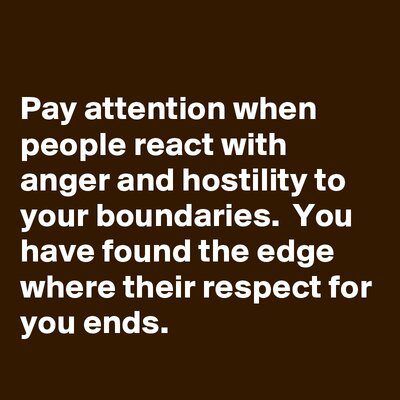Boundaries define us. They define what is me and what is not me.
We get what we tolerate in life, it is that simple. If you allow people to treat you unfairly because they are your family, parent, spouse, boss, or friend, the issue is not with them; it is with you. You need to set and communicate healthy boundaries with people or else they would continue to treat you in a way you do not appreciate.
Most of us think that boundaries should be common sense but it is not. Your job is to communicate with people what you would allow and what you would not allow. Your job is also to enforce the consequence of violating your boundaries. People don’t like to be told what to do, hence communicate your boundaries and if it gets violated; enforce the consequence. Boundaries without consequence is nagging. If you continue to give people the benefit of the doubt, eventually they would get the benefit and you get the doubt.
Boundaries without consequence is nagging.
Setting boundaries is exceptionally hard for most of us especially when it involves family, friends, and loved ones. It is tough because most of us have been brought up as people-pleaser, we do not want to rock the boat, we believe in forgiveness but remember when people do not see the consequence of their action, they repeat it. When you do not set healthy boundaries with people, it leads to resentment, energy-draining, crazymaking, drama, and chaos We stay in toxic and destructive relationships as we convince ourselves that we can not live life without some people.

What is a boundary?
Boundary (n.) “that which indicates the limits of anything,” from bound (n.1) + -ary. Strictly, a visible mark indicating a dividing line, a bound being the limit or furthest point of extension of any one thing.
Boundaries are expectations and needs that help you feel safe and comfortable in your relationships. A boundary is a cue to others about how to treat you. It can be explicit, such as saying “I’m about to share something that I’d like you to keep between just the two of us.” Or implicit, such as having a basket for shoes and socks right by the front door for guests. -1
Boundaries define us. They define what is me and what is not me. A boundary shows me where I end and someone else begins, leading me to a sense of ownership. In addition to showing us what we are responsible for, boundaries help us to define what is not on our property and what we are not responsible for. –2
American writer and psychotherapist Amy Bloom remarked: “Boundaries are the lines we draw that mark off our autonomy and that of other people, that protect our privacy and that of others. Boundaries allow for intimate connection without dissolving or losing one’s sense of self.” Bloom also noted that Good boundaries don’t mean that we never hurt each other’s feelings. Good boundaries mean the love is greater than etiquette or obligation but that love requires both—and that the rules for family life come from the heart as well as the head.
In their book, Boundaries: When to Say Yes, How to Say No to Take Control of Your Life, Dr. Henry Cloud, and Dr. John Townsend defined what boundaries are:
Boundaries define us. They define what is me and what is not me. A boundary shows me where I end and someone else begins, leading me to a sense of ownership. In addition to showing us what we are responsible for, boundaries help us to define what is not on our property and what we are not responsible for. We are not, for example, responsible for other people. Nowhere are we commanded to have “other-control,” although we spend a lot of time and energy trying to get it!
Boundaries are anything that helps to differentiate you from someone else, or shows where you begin and end.
People with poor boundaries struggle with saying no to the control, pressure, demands, and sometimes the real needs of others. They feel that if they say no to someone, they will endanger their relationship with that person, so they passively comply but inwardly resent. Sometimes a person is pressuring you to do something; other times the pressure comes from your own sense of what you “should” do. If you cannot say no to this external or internal pressure, you have lost control of your property and are not enjoying the fruit of “self-control.”
Types of Boundaries –2
We set boundaries to protect ourselves, emotional space, physical environment, mind, and spirituality. In relationships, boundaries define who we are and who we are not, which impacts every part of our lives:
- Physical: The wisdom to determine who may touch us and under what circumstances.
- Mental: The freedom to express our own thoughts and opinions.
- Spiritual: The clarity to distinguish God’s will for our lives.
- Emotional: The ability to manage our own feelings and disengage from the manipulative emotions of others.
Three levels of boundaries -1 - Porous
Porous boundaries are weak or poorly expressed and are unintentionally harmful. They lead to feeling depleted, overextending yourself, depression, anxiety, and unhealthy relationship dynamics. - Rigid
At the other extreme, rigid boundaries involve building walls to keep others out as a way to keep yourself safe. But staying safe by locking yourself in is unhealthy and leads to a whole other set of problems. Whereas porous boundaries lead to unhealthy closeness (enmeshment), rigid ones are a self-protective mechanism meant to build distance. This typically comes from a fear of vulnerability or a history of being taken advantage of. - Healthy
Healthy boundaries are possible when your past doesn’t show up in your present interactions. They require an awareness of your emotional, mental, and physical capacities, combined with clear communication.
Healthy boundaries look like
- Being clear about your values
- Listening to your own opinion
- Sharing with others appropriately
- Having a healthy vulnerability with people who’ve earned your trust
- Being comfortable saying no
- Being comfortable hearing no without taking it personally
What Boundaries are not - Not Threatening Consequences
Threatening consequences are what many people who struggle with setting a solid boundary do. They might yell and scream, or threaten divorce or to cut another person off, but they don’t mean it—and they and their partner both know it. The reason they do this is because they want their partner to know they are upset, but because they really don’t want to leave, threatening to leave and holding onto hope that their partner will change is all they really can do. - Fortressing
Fortressing is a very common stage that most people go through when they first learn to set boundaries—especially if they have been hurt multiple times. Instead of drawing lines in the sand in order to keep problematic people or situations at bay, they build high walls in an attempt to keep everyone out and to keep themselves safe and sane. This may happen for a number of reasons; perhaps they’ve been hurt too many times, or perhaps they don’t know what a healthy boundary is so they take it too far. Learning to navigate the difference between a healthy line in the sand and building a high wall takes time and practice. - Not an Ultimatum
With all kinds of boundaries, it’s key to understand this: the boundary is not for others, it’s for you. It is not an ultimatum to make another person behave a certain way. An ultimatum is a statement that assigns a consequence to someone else’s behavior as a means of trying to effect a change in it. A boundary, rather, is a personal limit that is expressed so that your need will directly be met. It is an action we take for ourselves regardless of how the other person reacts. That the other person may change in some way is a secondary gain. An important aspect of setting boundaries is allowing others to have their own limits and boundaries and respecting and honoring theirs while you maintain your own.”
An ultimatum is a statement that assigns a consequence to someone else’s behavior as a means of trying to effect a change in it. A boundary, rather, is a personal limit that is expressed so that your need will directly be met. It is an action we take for ourselves regardless of how the other person reacts.
We don’t need to have so many boundaries that people can’t get near us, however. We don’t want to be doormats, but we don’t want to be porcupines either. Doormats get walked on, but porcupines can’t be hugged. (The New Codependency, 2009)
BOUNDARIES AREN’T:
• limits we set because someone told us to;
• empty, angry threats;
• power plays to control someone;
• limits we don’t or can’t enforce.
THE ONLY NON-NEGOTIABLE BOUNDARIES ARE:
• don’t hurt yourself,
• don’t hurt anyone else,
• don’t let anyone hurt you.
Call 911 to report abuse, then don’t get close enough to an abuser to be hurt.
It’s easy to think that most people know not to allow themselves to be abused. But statistics on abuse from a wide range of sources are staggering. Although the numbers vary, about six people every minute in the United States are seriously hurt by someone they know and love. 5
About six people every minute in the United States are seriously hurt by someone they know and love.
Boundaries vs Controlling
Boundaries concern our behaviors. We don’t set them to control or interfere with people’s free will—unless someone is harming us. Boundaries may involve consequences. We say, “If you do this, I’ll do that.” Boundaries give people choices. They can do as they please, but we can, too.
It’s not a boundary if we can’t enforce it.
Be clear. If people have room to misinterpret, they will. People hear what they want to and what causes the least pain. We won’t be clear with others if we’re not clear with ourselves. Sometimes we don’t like their behavior, but we don’t want to lose the relationship, so our boundaries are murky. We can’t have it both ways; it’s either a boundary or it’s not.
Why set Boundaries
Clinical psychologist, and creator of “the holistic psychologist” Dr. Nicole LePer, In her book, How to Do the Work: Recognize Your Patterns, Heal from Your Past and Create Your Self, writes about why we need to set healthy boundaries:
Drawing a boundary with someone involves letting someone know what is and isn’t okay with you, and then having some sort of enforceable consequence if they cross that line, or if they cross it again. Boundaries protect you. They keep you physically balanced. They help you connect to your intuitive Self and are critical to experiencing authentic love. Boundaries provide a necessary foundation for every relationship you have—most importantly the one you have with yourself. They are the retaining walls that protect you from what feels inappropriate, unacceptable, inauthentic, or just plain not desired.
Boundaries are the retaining walls that protect you from what feels inappropriate, unacceptable, inauthentic, or just plain not desired.
Communication is Key
Boundaries are not unspoken rules – 1
People can’t meet a standard that we never express. Boundaries are not unspoken rules. Unspoken boundaries are invisible, and they often sound like “They should’ve known better” or “Common sense would say . . .” Common sense is based on our own life experiences, however, and it isn’t the same for everyone. That’s why it’s essential to communicate and not assume that people are aware of our expectations in relationships. We must inform others of our limits and take responsibility for upholding them.
Common sense is based on our own life experiences, however, and it isn’t the same for everyone.
How to Set a Boundary – 1
Step #1
Be clear. Do your best to be as straightforward as possible. Mind your tone—don’t yell or whisper. People will miss the boundary if you use complicated words or jargon. Take a deep, deep breath, and focus on being precise.
Step #2
Directly state your need or request, or say no. Don’t just mention what you don’t like; ask for what you need or want. Identify your expectations, or decline the offer.
Step #3
Dealing with the discomfort that happens as a result of setting boundaries is the hardest part. Discomfort is the number one reason we want to bypass setting them. It’s common afterward to feel guilty, afraid, sad, remorseful, or awkward.
Communicating your Boundaries
Boundary Statements: I Want . . . , I Need . . . , I Expect . . .1
The best boundaries are easy to understand. Starting statements with “I need,” “I want,” or “I expect” helps you stay grounded in the truth of who you are.
Use Objective Language -3
“When you state your boundary, it is helpful to use objective language as much as possible. You want to focus on facts. “If a phone call occurs in the middle of the night while I’m sleeping, it will go unanswered.” It’s best to avoid “you” language as much as possible, as it can activate the defensiveness of the other person’s ego. Try to be confident and respectful, as hard as this may be. Remind yourself you are doing nothing wrong. You are respecting yourself and your relationship.”
Example of a boundary-setting template that can be adapted to fit your needs: – 3
“I am making some changes so that [insert your intention for your new boundary] and hope you can understand that this is important to me. I imagine [insert your understanding of their behavior]. When you [insert problematic behavior], I often feel [insert your feelings], and I understand that is something you may not be aware of. In the future, [insert what you would or would not like to happen again]. If [insert original problematic behavior] happens again, I will [insert how you will respond differently to meet your own needs].”
“I am making some changes so that [ ], and I hope you can understand that this is important to me. I imagine [ ]. When you [ ], I often feel [ ], and I understand this is something you may not be aware of. In the future, [ ]. If [ ] happens again, I will [ ].”
Benefits of Setting Healthy Boundaries –1
Situations, relationships, and people struggle to survive without boundaries. Here are just a few of the benefits:
- People with boundaries sleep better.
- People with boundaries experience less burnout.
- People with boundaries have healthier relationships that tend to last longer.
- People with boundaries experience less stress.
- People with boundaries feel more joyful.
- People with boundaries benefit from the short- and long-term value of setting them.
“If you don’t like being a doormat then get off the floor.”– Al Anon
Why Boundaries are hard to set
In her book, Healing from Hidden Abuse: A Journey Through the Stages of Recovery from Psychological Abuse, psychotherapist Shannon Thomas, LCSW noted why setting boundaries can be hard to set and even enforce.
When we decide that boundaries are needed, they can be hard to set – and maintain. We need to set healthy boundaries if the behaviors of others show their lack of respect for us and our health. Boundaries do not have to be melodramatic or forceful in their application. Boundaries can be quiet and steadfast. We are setting good and healthy boundaries when we simply refuse to engage in a useless argument with a toxic person. Another reason setting boundaries is difficult to do? We internally worry that we are withholding forgiveness and staying resentful. Boundaries have nothing to do with forgiveness or resentment. They have everything to do with the quality of our interactions with the people in our lives.
Boundaries have nothing to do with forgiveness or resentment. They have everything to do with the quality of our interactions with the people in our lives.
Our time here on earth is limited and the prognosis of life is death. You have on average 30,000 days to be alive, of which 10,000 days would be spent sleeping, another 4,000 for work, commute, play, etc. Spending that limited time with people that would drain and continuously violate your boundaries is not really worth it. You only live once and if you guard your time, boundaries, and space well, it would be worth it.
References
1 – Set Boundaries, Find Peace: A guide to reclaiming yourself by Nedra Tawwab
2 – Boundaries: When to Say Yes, How to Say No to Take Control of Your Life by Dr. Henry Cloud
3 How to Do the Work: Recognize Your Patterns, Heal from Your Past, and Create Your Self by Dr. Nicole LePer
4 – Healing from Hidden Abuse: A Journey Through the Stages of Recovery from Psychological Abuse
5. The New Codependency: Help and Guidance for Today’s Generation by Melody Beattie
All the Best in your quest to get Better. Don’t Settle: Live with Passion.



Comments are closed.